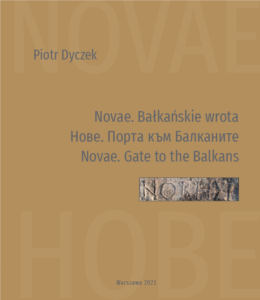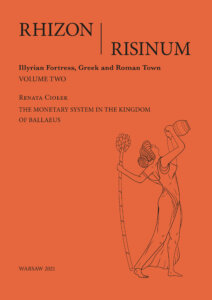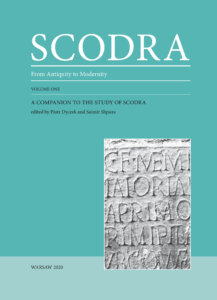Publications

The Center publishes the journal NOVENSIA, the archival issues of which are fully available online.
The journal is indexed in ERiH database and is listed in the Ministry list for 100 points.
If you are interested in information about the current issue, archives and potential authors, please visit the journal’s website: novensia.uw.edu.pl
Books published by the Centre:
 |
P. Dyczek, Novae. Bałkańskie wrota / Нове. Порта към Балканите / Novae. Gate to the Balkans, Warszawa 2021, 168 pp. |
 |
R. Ciołek, The Monetary System in the Kingdom of Ballaeus = RHIZON / RISINUM. Illyrian Fortress, Greek and Roman Town, Volume Two.
|
 |
P. Dyczek, S. Shpuza (eds.), Scodra. From Antiquity To Modernity volume 1. Warszawa 2020, 404 pp.
|
 |
J. Martinović, T. Płóciennik, Epigrafika Crne Gore.
A monumental compendium of Greek, Latin and Old Slavic inscriptions discovered in the territory of the Bay of Kotor in Montenegro. |
 |
K. Kozłowski, M. Nowak, I przyszli ludzie zza Gór Wysokich. Ziemie Polskie od VI do IV Tysiąclecia BC, Rzeszów-Warszawa 2019.
This publication, published jointly with the Institute of Archaeology of the University of Rzeszów, describes the migration and culture-formation processes that took place in Polish lands from the 6th to the 4th millennium BC. Price: 100 PLN |
 |
J. Kolendo, T. Płóciennik
Vistula amne discreta This fascinating work is the result of the collaboration between the late Professor Jerzy Kolendo and Tomasz Płóciennik. The book describes and analyzes Greek and Latin sources for the most ancient history of the Polish lands. Price: 40 PLN |
 |
S. Kozłowski
Kwiat Królestwa. Archeologów Polskich Pokolenie Trzecie. 2015 The author describes the history of Polish archaeology, as usual in an extremely interesting and brilliant way. Price: 70 PLN |
 |
P. Dyczek (red.), Tak się wszystko zaczęło. Śladami Polaków w Czarnogórze.
The book contains various stories and biographies of people whose fate took them to the beautiful country on the Adriatic Sea.
|
 |
Kozlowski Stefan Karol (red.), Stefan Krukowski i jego przygoda z PMA. Warszawa, Lodz 2014, ss. 1-211.
The book is a collective work and presents the history of the State Archaeological Museum in Warsaw in the years 1921-1949 and selected episodes from the life of Stefan Krukowski, an outstanding prehistorian who was associated with the museum for many years. In the first part the work reveals, among other things, new facts about the rules of the museum, the project of its pre-war headquarters and describes the establishment of the Paleolithic Department. The second part shows Stefan Krukowski’s battles with the Warsaw archaeological community and his cooperation with Jurij Polanski. Finally, it sheds light on the hero’s wartime fate.
|
 |
P. Dyczek, Rhizon, Warszawa 2013, ss. 144, ISBN 978-83-934239-8-9
Price: 50 PLN An album dedicated to the history and excavations in Risan, Montenegro, accompanied by a rich selection of beautiful photographs. |
 |
P. Dyczek, Iliria i prowincje bałkańskie w Zjednoczonej Europie/Iliria dhe provincat ballkanike në Evropën e Bashkuar/Illyria and the Balcar Provinces in United Europe, Warszawa 2011, ss. 140, figs. 118, ISBN 978-83-928330-8-6. Price 30 PLN
A trilingual Polish-Albanian-English trilogy publication, presenting the results of archaeological research conducted by the Centre in Novae (Bulgaria) and ancient Rhizon/Risinium (Montenegro). It also includes information about the “treasure of coins of King Ballaios of Risan” and the results of this year’s campaign in Risan, during which the so-called House of Aglaos and a magnificent gold ring were discovered. The individual chapters focus on the most interesting scientific issues and the most interesting, and unique results of our research. The book is lavishly illustrated and includes primary literature. |
 |
Ciołek, P. Dyczek, Novae. Legionary Fortress and Late Antique Town, ed. P. Dyczek. Volume Two. Coins from Sector IV, Warszawa 2011.
A monography on the coins from sector IV in Novae |
 |
S. Jilek, P. Dyczek, M. Lemke, The Danube Limes, A Roman River Frontier, Warsaw 2009
The book was written as part of the Danube Limes project (see Research) and was a concise monograph about the frontier sites on the Danube of the Roman Empire. |
 |
T. Derda, P. Dyczek, J. Kolendo [eds.], Novae : Legionary Fortress and Late Antique Town, vol. I: A Companion on the Study of Novae, Warsaw 2008 [2009]
The first volume of a monographic series on the site of Novae. The volume includes articles on the history of research, Novae in ancient sources, the history of the site, geography, topography, and cartography, and an extensive bibliography on Novae covering the years 1726-2008. Price: 50 PLN |
 |
A. Dimitrova – Milceva, Die Bronzefunde aus Novae Moesia Inferior., Warszawa 2006, ISBN 83-916770-3-6. Publikacja dofinansowana w ramach programu Cultura 2000.
The author, a well-known Bulgarian researcher and long-time leader of the Bulgarian expedition in Novae, presents figural braziers in her work. These monuments come primarily from the excavations of archaeologists of Bulgaria and museum collections. The braziers from the excavations of Polish archaeologists will be published separately as part of the overall publication of the results of the Novae research. The synthetic part, in which the main conclusions of the whole analysis of the monuments are indicated, is followed by the catalog part. Each monument is described and illustrated, basic literature is also given. The book is a very good source for all researchers dealing not only with bronzes, but with the art of the Roman provinces in general |
 |
P. Dyczek, Roman Amphorae of the 1st –3rd centuries AD found on the Lower Danube. Typology, Wydawnictwa Uniwersytetu Warszawskiego, Warszawa 2001. ISBN 83-235-0138-6,
This book presents a new typology of amphorae found in the Lower Danube area. It presents the origin of the types, their variants, basic data on individual amphorae, dating, epigraphy, detailed areas of occurrence, analogies and – something which has not been done before – the results and conclusions of the physical and chemical analyses, which constitute a kind of database for other researchers. The work is not limited to strictly typological issues, but also presents an outline of economic relationships and the importance of amphorae in trade. |
 |
J. Kolendo, J. Żelazowski, Teksty i pomniki. Zarys epigrafiki łacińskiej okresu Cesarstwa Rzymskiego, Warszawa 2003, ISBN 83-916-770-2-8,
In every respect this work is unique, not only in Poland, for it contains a complete lecture on Latin epigraphy together with a list of epigraphic and bibliographical abbreviations The authors analyze the concept of epigraphic source, describe the workshop of the epigrapher and then the particular elements of various types of inscriptions. A separate chapter is devoted to dating of inscriptions and Latin epigraphy in Poland. The book is richly illustrated with inscriptions coming mainly from the excavations in Novae.
|
